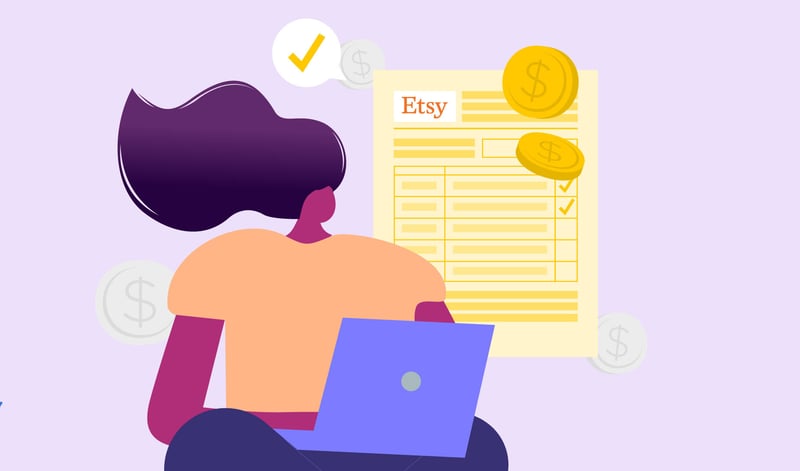Etsy Fees are the charges Etsy takes from sellers for listing items, processing payments, and completing sales, including listing fees, transaction fees, and payment processing costs. These fees matter because they directly affect your profit on every order and play a major role in how you should price your products on Etsy.
This article breaks down exactly how much Etsy takes from sellers, explains each Etsy fee with real examples, and shows how those costs add up per sale. You’ll also see how an Etsy fee calculator helps estimate net earnings, so you can make informed pricing decisions and protect your margins as your shop grows.
To learn about how to get started selling on Etsy, check out A Reseller’s Guide to Etsy.
Unveiling Seller Etsy Fees
When selling on Etsy, it's important to be aware of the different fees levied by the platform, as they contribute to the overall cost of doing business. Understanding these fees will enable you to calculate your profit margins effectively.
As a very rough estimate, you can expect that you will pay twelve percent in total Etsy fees:
Etsy charges a listing fee of $0.20 per item (which renews every 4 months), a sale fee of 6.5% of the sale price, and a payment processing fee of 3% plus $0.25 (US only).
Total fees depend on a number of factors. Let’s explore them:
Listing Fee:
Etsy charges a listing fee of $0.20.
To list an item on Etsy, sellers are required to pay a nominal fee of $0.20 per item. This fee covers the cost of displaying your product in the marketplace and it renews every four months that your item goes unsold. The Etsy listing fee is non-refundable, regardless of whether your item sells or not. It's important to consider this cost when determining your pricing strategy and deciding how many items to list.
Note that additional fees apply if you sell items internationally or if you promote your listings. If you’re a high-volume, multi-quantity seller, you will be subject to other mandatory promotional fees like off-site ads. For more information about the Various Etsy fees, click here.
Transaction Fee:
The Etsy transaction fee is 6.5% of the sale price.
Etsy charges a transaction fee on each sale made through the platform. This fee is five percent of the total sale amount, which includes the item's price and any associated shipping costs. It is crucial to factor this fee into your pricing strategy to ensure you're accounting for it when setting your item prices.
Note: If you offer free shipping, a shipping fee will apply as well.
Payment Processing Fee:
The Etsy payment processing fee is 3% plus $0.25.
When a buyer makes a purchase on Etsy, the platform handles the payment processing and charges a fee for this service. The fee is calculated as a percentage of the total sale amount, including shipping fees. Note that this is for US sales only.
The listing fee, transaction fee, and payment processing fee are the three main types of fees that every sale is subject to. There may be other applicable fees, though. See below.
Decoding How Much Etsy Takes Per Sale
Under a basic sale with just the three main types of fees in play, you can expect the following:
If you sell a pair of vintage jeans on Etsy for $20, you will make $17.65 after fees under the following parameters:

- They sold within 4 months of listing (insertion fee was $0.20, once)
- You did not promote the listing in any way
- The sale was within the United States.
Sale Price: $20
Etsy fee: $2.35
You make: $17.65
However, see below as there are additional fees that might apply. These are important to understand to calculate your profit:

Additional Etsy Fees
Shipping Label Fees
If you purchase shipping labels through Etsy, you will be charged shipping label fees (especially if you offer free shipping).
Etsy offers a convenient solution for printing postage labels at a discounted rate when your order is ready for shipment. However, it's important to note that this service is not compatible with print-on-demand items.
The packaging of your product plays a significant role in leaving a positive impression on customers. By purchasing postage labels, you can customize your items and provide added value to the buyer right from the moment they receive their package.
Currently, Etsy supports shipping labels through several trusted carriers, including Australia Post, Canada Post, FedEx, Global Postal Shipping, USPS, and Royal Mail. The cost of label shipping is determined by factors such as the package's origin, destination, and dimensions.
It's worth mentioning that Etsy offers a generous 30% discount on the average postal shipping fee when using USPS shipping.
To learn more about shipping with Etsy, check out A Reseller’s Guide to Etsy.
Region-Specific Etsy Fees:
Region-specific fees generally apply to international sales. These are entirely dependent on your store's listing currency, your buyer’s location, applicable taxes, payment processor, and others.
Etsy Subscription Fees:
Serious about Etsy? You also might consider an Etsy Plus Subscription. For only $10/month, you’ll receive many benefits.
Etsy Handling Fees
Handling fees are charged by the seller and paid by the buyer. In the Etsy listing form, you might choose to charge a handling fee to your buyers. The handling fee is an amount charged to every customer on top of the order subtotal and shipping fees. You can enter any value in this field. Note that the Etsy selling fees apply to this charge as well, so you don’t get all of it. This is very controversial in the Etsy Community. While some sellers charge a small amount to mitigate the cost of packaging supplies, most suggest that you do not charge a handling fee.
Promotional Fees on Etsy:
There are various ways to promote your Etsy listings. Promotional fees are optional (until you hit $10k in sales within 365 days at which point they become mandatory).
Etsy employs various marketing techniques that can be applied to multiple advertising strategies. The primary method of advertising on the Etsy marketplace is through Etsy Ads. By using Etsy Ads, your selected listing is strategically positioned in prominent locations within the user catalog, search results, and category pages. Etsy also provides sellers the opportunity to use offsite advertising. Let’s talk about both:
Etsy Ad Fees:
Etsy ad fees are optional but very much worth it.
If you opt-in to Etsy Advertising in your Shop Manager, you can set a daily budget for advertising your listings on the Etsy website. You can track the metrics and performance of your ads, and the structure is very similar to that of eBay promotions.
Offsite Ad Fees:
Offsite ad fees are optional (until you reach $10k in sales in 365 days at which point they become mandatory).
Etsy offsite ads provide an avenue for advertisement on various social networks and search engines. With offsite ads, you pay fees only if your sale is made as a direct result of the ad.
This is mandatory for accounts once they reach a sales threshold, and the fees vary by account. Learn more here
If you participate in Etsy promotions, Etsy evaluates and measures the performance of your ads, granting them increased visibility if your listing is in high demand due to optimized tags and product quality or if you allocate a higher cost-per-click budget compared to your competitors. Keeping an eye on these metrics is an excellent approach to discovering ways to enhance your sales on Etsy.
In terms of advertising fees, Etsy provides options for selecting a daily budget. Opting for a higher budget will influence the frequency at which your Etsy Ads are displayed on users' pages. Moreover, by subscribing to a paid Etsy plan, you can earn credits for Etsy Ads, entitling you to a bonus amount for your ad listings.
Unlock Explosive Growth: Sign Up for Vendoo and Start Crosslisting Today!
Ways to Save on Etsy Seller Fees
-
Increase Your Prices
-
Set Your Prices in Your Bank Account’s Currency
-
Use Promotional Tools Selectively
-
Ship Through Etsy
Increase Prices
The simplest way to reduce Etsy fees is by increasing your profit margins. If you consistently generate sales for certain items, don't hesitate to raise their prices to reflect their value.
A small raise to your prices will help you to maintain or increase profit despite various fees. However, be cautious about potential customer alienation when increasing prices. In such cases, consider compensating by allocating a higher budget for advertising to attract new buyers.
When adjusting prices, pay attention to the impact on your competition. Avoid overpricing your products above the market average. Stay within the range observed among other Etsy sellers and evaluate the long-term sales effects of price fluctuations.
Ship Through Etsy Shipping
Shipping with Etsy labels can save you quite a bit in shipping fees. This is especially valuable when you offer free shipping, which can significantly influence buyer behavior. When you’re paying for the shipping, it is important to find the most affordable option.
Fees can vary depending on the destination of your order, and they can impact your projected business expenses. Etsy offers a number of shipping options with decent rates for sellers. For example, Printify strives to optimize your orders by selecting the nearest fulfillment center, but there is a risk of increased shipping costs.
Learn more about Etsy shipping label options here.
Set Prices in Your Bank Account's Currency
To avoid Etsy's 2.5% currency conversion fee, ensure that your listings and bank account use the same currency.
If you sell to customers outside of your business country, consider using an international bank account for eCommerce billing. Maintaining a separate business account will facilitate expense calculations and enable you to develop a profitable cost-to-sell model.
Use Promotional Tools Selectively
Etsy Ads and Off-site Ads are opportunities to showcase your best offerings. When selecting your primary ad listing, choose your best-selling items. You might not choose to promote everything.
Etsy closely monitors on-site and off-site ads. The algorithm prioritizes listings with carefully chosen tags, well-crafted descriptions, and a high click-through rate.
When advertising off-site, ensure compliance with the platform's terms of service and target your marketing efforts based on the desired audience.
In conclusion, understanding Etsy fees is vital for sellers looking to maximize their profits and run a successful business on the platform. By familiarizing yourself with the various fees, such as listing fees, transaction fees, payment processing fees, and region-specific fees, you can accurately calculate your costs and set appropriate pricing strategies.
Optional fees, like advertising and customization features, offer additional opportunities for sellers to enhance their Etsy stores and reach a wider audience. Implementing strategies to save on fees can further optimize your earnings. By grasping the intricacies of Etsy fees and employing smart tactics, you can navigate the platform confidently and thrive as an Etsy seller.
If you're excited to explore new marketplaces and compare their features, take a look at Top Rated Online Marketplaces.
You might also be interested in A Reseller's Guide to Marketplace Fees.
Ready to start crosslisting? Sign up for Vendoo for FREE today!







